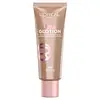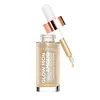What's inside
What's inside
 Key Ingredients
Key Ingredients

 Benefits
Benefits

 Concerns
Concerns

 Ingredients Side-by-side
Ingredients Side-by-side

Water
Skin ConditioningGlycerin
HumectantDimethicone
EmollientAlcohol Denat.
AntimicrobialButyrospermum Parkii Butter
Skin ConditioningCI 77891
Cosmetic ColorantAmmonium Polyacryloyldimethyl Taurate
Emulsion StabilisingSynthetic Fluorphlogopite
Polyglyceryl-6 Distearate
EmulsifyingMica
Cosmetic ColorantPolysilicone-11
Phenoxyethanol
PreservativePentaerythrityl Tetraethylhexanoate
EmollientJojoba Esters
EmollientCapryloyl Salicylic Acid
ExfoliatingCaprylyl Glycol
EmollientSodium Citrate
BufferingPolyacrylamide
CI 77491
Cosmetic ColorantBoron Nitride
AbsorbentPolyglyceryl-3 Beeswax
EmulsifyingCetyl Alcohol
EmollientC13-14 Isoparaffin
EmollientAdenosine
Skin ConditioningDisodium EDTA
Citric Acid
BufferingLaureth-7
EmulsifyingSodium Stearate
CleansingTin Oxide
AbrasiveCetearyl Alcohol
EmollientTriethoxysilylethyl Polydimethylsiloxyethyl Dimethicone
Skin ConditioningIsopropyl Titanium Triisostearate
EmollientAlumina
AbrasiveCeteareth-20
CleansingCalcium Chloride
AstringentWater, Glycerin, Dimethicone, Alcohol Denat., Butyrospermum Parkii Butter, CI 77891, Ammonium Polyacryloyldimethyl Taurate, Synthetic Fluorphlogopite, Polyglyceryl-6 Distearate, Mica, Polysilicone-11, Phenoxyethanol, Pentaerythrityl Tetraethylhexanoate, Jojoba Esters, Capryloyl Salicylic Acid, Caprylyl Glycol, Sodium Citrate, Polyacrylamide, CI 77491, Boron Nitride, Polyglyceryl-3 Beeswax, Cetyl Alcohol, C13-14 Isoparaffin, Adenosine, Disodium EDTA, Citric Acid, Laureth-7, Sodium Stearate, Tin Oxide, Cetearyl Alcohol, Triethoxysilylethyl Polydimethylsiloxyethyl Dimethicone, Isopropyl Titanium Triisostearate, Alumina, Ceteareth-20, Calcium Chloride
Hydrogenated Polyisobutene
EmollientIsododecane
EmollientIsononyl Isononanoate
EmollientIsodecyl Neopentanoate
EmollientSynthetic Fluorphlogopite
Dimethicone
EmollientHydrogenated Styrene/Isoprene Copolymer
Butyrospermum Parkii Butter
Skin ConditioningDisteardimonium Hectorite
StabilisingCocos Nucifera Oil
MaskingPEG-10 Dimethicone
Skin ConditioningPropylene Carbonate
SolventDimethiconol
EmollientBHT
AntioxidantParfum
MaskingTin Oxide
AbrasiveCalcium Sodium Borosilicate
Alumina
AbrasiveCalcium Aluminum Borosilicate
Tris-BHT Mesitylene
AntioxidantLimonene
PerfumingLinalool
PerfumingMagnesium Silicate
AbsorbentHexyl Cinnamal
PerfumingSilica
AbrasiveBenzyl Salicylate
PerfumingBenzyl Alcohol
PerfumingTocopherol
AntioxidantCitronellol
PerfumingAlpha-Isomethyl Ionone
PerfumingBenzyl Benzoate
AntimicrobialCoumarin
PerfumingCitral
PerfumingBenzyl Cinnamate
PerfumingCitric Acid
BufferingCI 77891
Cosmetic ColorantCI 77491
Cosmetic ColorantCI 77492
Cosmetic ColorantCI 77499
Cosmetic ColorantMica
Cosmetic ColorantCI 77007
Cosmetic ColorantCI 77742
Cosmetic ColorantCI 77400
Cosmetic ColorantCI 77000
Cosmetic ColorantCI 75470
Cosmetic ColorantHydrogenated Polyisobutene, Isododecane, Isononyl Isononanoate, Isodecyl Neopentanoate, Synthetic Fluorphlogopite, Dimethicone, Hydrogenated Styrene/Isoprene Copolymer, Butyrospermum Parkii Butter, Disteardimonium Hectorite, Cocos Nucifera Oil, PEG-10 Dimethicone, Propylene Carbonate, Dimethiconol, BHT, Parfum, Tin Oxide, Calcium Sodium Borosilicate, Alumina, Calcium Aluminum Borosilicate, Tris-BHT Mesitylene, Limonene, Linalool, Magnesium Silicate, Hexyl Cinnamal, Silica, Benzyl Salicylate, Benzyl Alcohol, Tocopherol, Citronellol, Alpha-Isomethyl Ionone, Benzyl Benzoate, Coumarin, Citral, Benzyl Cinnamate, Citric Acid, CI 77891, CI 77491, CI 77492, CI 77499, Mica, CI 77007, CI 77742, CI 77400, CI 77000, CI 75470
Ingredients Explained
These ingredients are found in both products.
Ingredients higher up in an ingredient list are typically present in a larger amount.
Alumina is another name for the compound aluminum oxide. It is used as a thickener, absorbent, and abrasive.
As an absorbent, alumina can give a mattifying effect. It is used in mineral sunscreens to help coat nano-sized filters, such as titanium dioxide. By increasing the size of the UV filters, these ingredients stay on the skin for a longer time. By coating small sized ingredients, alumina helps thicken a product.
Alumina may be used as an abrasive, or exfoliant.
Alumina is naturally occurring in the mineral corundum. Certain varieties of corundum create rubies and sapphires. Corundum is also the crystalline form of alumina.
Learn more about AluminaThis ingredient is also known as shea butter. It is an effective skin hydrator and emollient.
Emollients help soothe and soften your skin. It does this by creating a protective film on your skin. This barrier helps trap moisture and keeps your skin hydrated. Emollients may be effective at treating dry or itchy skin.
Shea butter is rich in antioxidants. Antioxidants help fight free-radicals, or molecules that may harm the body. It is also full of fatty acids including stearic acid and linoleic acid. These acids help replenish the skin and keep skin moisturized.
While Shea Butter has an SPF rating of about 3-4, it is not a sunscreen replacement.
Shea butter may not be fungal acne safe. We recommend speaking with a professional if you have any concerns.
Learn more about Butyrospermum Parkii ButterCi 77491 is also hydrated iron III oxide. It's sole purpose is to give a red/pink hue to products.
Iron III oxides are classified as inorganic chemicals for coloring.
Synthetically created Ci 77491 is considered safer than those naturally found. This is because the synthetically created version may contain less impurities. Iron oxides are generally non-toxic and non-allergenic.
Learn more about CI 77491Ci 77891 is a white pigment from Titanium dioxide. It is naturally found in minerals such as rutile and ilmenite.
It's main function is to add a white color to cosmetics. It can also be mixed with other colors to create different shades.
Ci 77891 is commonly found in sunscreens due to its ability to block UV rays.
Learn more about CI 77891Citric Acid is an alpha hydroxy acid (AHA) naturally found in citrus fruits like oranges, lemons, and limes.
Like other AHAs, citric acid can exfoliate skin by breaking down the bonds that hold dead skin cells together. This helps reveal smoother and brighter skin underneath.
However, this exfoliating effect only happens at high concentrations (20%) which can be hard to find in cosmetic products.
Due to this, citric acid is usually included in small amounts as a pH adjuster. This helps keep products slightly more acidic and compatible with skin's natural pH.
In skincare formulas, citric acid can:
While it can provide some skin benefits, research shows lactic acid and glycolic acid are generally more effective and less irritating exfoliants.
Most citric acid used in skincare today is made by fermenting sugars (usually from molasses). This synthetic version is identical to the natural citrus form but easier to stabilize and use in formulations.
Read more about some other popular AHA's here:
Learn more about Citric AcidDimethicone is a type of synthetic silicone created from natural materials such as quartz.
What it does:
Dimethicone comes in different viscosities:
Depending on the viscosity, dimethicone has different properties.
Ingredients lists don't always show which type is used, so we recommend reaching out to the brand if you have questions about the viscosity.
This ingredient is unlikely to cause irritation because it does not get absorbed into skin. However, people with silicone allergies should be careful about using this ingredient.
Note: Dimethicone may contribute to pilling. This is because it is not oil or water soluble, so pilling may occur when layered with products. When mixed with heavy oils in a formula, the outcome is also quite greasy.
Learn more about DimethiconeMica is a naturally occurring mineral used to add shimmer and color in cosmetics. It can also help improve the texture of a product or give it an opaque, white/silver color.
Serecite is the name for very fine but ragged grains of mica.
This ingredient is often coated with metal oxides like titanium dioxide. Trace amounts of heavy metals may be found in mica, but these metals are not harmful in our personal products.
Mica has been used since prehistoric times throughout the world. Ancient Egyptian, Indian, Greek, Roman, Aztec, and Chinese civilizations have used mica.
Learn more about MicaSynthetic Fluorphlogopite is the synthethic version of mica. It consists of fluorine, aluminum and silicate.
Synthetic Fluorphlogopite is used to add volume to products.
It is considered non-irritating on the skin.
Learn more about Synthetic FluorphlogopiteTin Oxide is an inorganic oxide used to add opacity and volume to a product. In nature, it is already found in mineral form. The main ore of tin is an opaque and shiny mineral called casseterite.
Tin Oxide helps remove translucency in a product, or make it more opaque. Besides adding opacity, tin oxide is used for bulking to add volume.